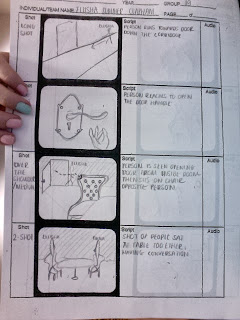Evaluation
Brief:
We had to film a short scene between two people that involved shot reverse shot, the 180 degree line rule and match on action.
A shot reverse shot is a film technique where one character is shown looking (usually off-screen) at another character, and then the other character is shown looking back at the first character. Since the characters are shown facing in opposite directions, the viewer unconsciously assumes that they are looking at each other.
The 180 degree rule is a filming guideline that states that the characters shown in the scene, should have the same left relationship to each other, this will make the audience have a better sense of the surroundings and what is happening in the scene. If this rule is not used correctly it will look like the characters are constantly swapping sides.
A match on action shot is when what happens in one shot is continued over and completed in a different shot at a different angle for example when we opened the door in our scene.
What planning did you do?
Before shooting the scene we had to plan it out in various ways. Firstly by using Script Celtx and writing a script. We were told that we had to have a person walking down a corridor, walking into a room and having a short conversation with another person. After we had written a script we made a story board which explained in detail what would happen in the scene and what shots we would include. As well as this we did some research location beforehand to see if the place we wanted to film would be large enough and the sound there would not interrupt our filming. Then, finally, we took a risk assessment to make sure that we were aware what to do when we were filming, and what to look out for to minimise accidents and injuries.
How did you film the piece and what problems did you come across?
We used a tripod to film our scene because we didn't want the camera to be jumpy as it would be if it was a hand help camera. We had our scripts and story boards on hand and kept on referring to them to see what shot we needed to do and what needed to be said. We took various takes to make sure we had what we needed and so it would agree with the match on action. However we did come across a few problems. For starters there was sometimes a lot of noise in the background that was in between shots and didn't quite fit in with what was happening on screen. We resolved this problem again by taking various shots and then when it came to editing, picking the best shots.
How did you edit it?
We used final cut express. We were able to drag the shots we wanted onto the time line and edit them together so they had a good match on action, were able to show shot reverse shot and agreed with the 180 degree line rule. We linked sound clips of each shot together in some places so that the sound continued on and flowed easily.
How does it demonstrate shot reverse shot, the 180 degree line rule and match on action?
Several shot reverse shots are used throughout the scene when the two characters are sat down in the room and talking to each other. This was for the audience to get a better understanding of the location and so the camera wasn't just on one person. The 180 degree line rule was used constantly throughout the scene. When we shot the shot reverse shots we made sure we filmed each one on the left side of each character so that the rule would not be broken and it wouldn't look like the characters had swapped places. Finally match on action was used when the door was opened and the character walked into the room. We used a close up shot of the door handle, and the character beginning to walk in, then it cut to a long shot inside the room of the character continuing to walk in. This editing technique made the scene look continuous with no errors.







